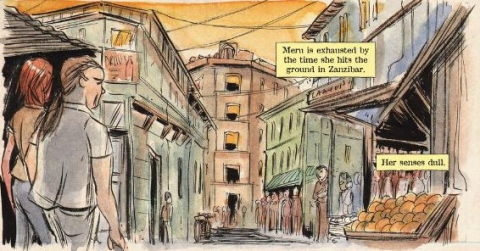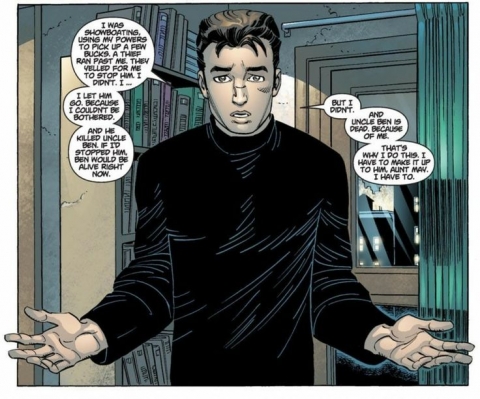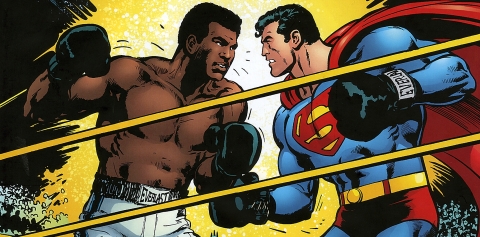52 weeks. 52 different writers. 2 trade paperbacks or hardcovers a week. Each week I’ll take a look at a different writer and read two different collected editions from within that person’s repertoire to help in the examination of their work.
Matt Kindt is perhaps best known for his comic works largely involving spies and general espionage. Back in the 90’s, Kindt worked in the local mini-comics scene, basing himself out of St.Louis, Missouri. In 2001 he published his first graphic novel through Top Shelf Entertainment called Pistolwhip. It was nominated for a Harvey Award the following year as well as being well received by critics yet it still remained a relatively obscure title. Kindt continued working with Top Shelf as well as other publishers including Dark Horse and Vertigo, producing plenty of well-received spy related work. In 2012, Matt Kindt began releasing his first ever solo ongoing series, MIND MGMT, through Dark Horse. The book received strong critical acclaim, with the first collected edition being on the New York Times Bestseller list for two weeks.
MIND MGMT Vol 1: The Manager
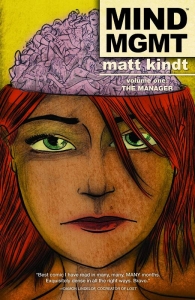 The 210 passengers on Flight 815 all suddenly forget who they are or what they are doing on the plane. Shocked, scared, and racing to survive, the passengers are confused and in disbelief as they can’t even recognize themselves. By some form of a miracle, the plane is landed safely and all the passengers disembark which leads to another layer of peculiar mystery surrounding the plane. After a careful examination of the flight manifest, the world is set into a state of uproar and curiosity when it is revealed that there was actually 211 passengers on the plane, with one Henry Lyme never being interviewed or found. Two years after the accident, a somewhat successful writer named Meru decides to take the plunge to try to track down Henry Lyme for her next book, even if it takes her to the edge of the Earth. Meru’s agent’s patience has grown thin from her lack of recent success but he sends her away on a mysterious assignment to Mexico to help her with her new book. When Meru arrives she discovers a village of starved bodies and thousands of empty pots, unable to shake the feeling that this is somehow connected to Flight 815. Things only get weirder for Meru when she discovers she’s being trailed by the CIA during her search for Henry Lyme and that they may be the only people who can attempt to keep her safe from a mysterious pair called “The Immortals”. Henry Lyme, The Immortals, The CIA, and Meru. It’s all connected and begins to unravel the tale surrounding a group referred to as “Mind Management”.
The 210 passengers on Flight 815 all suddenly forget who they are or what they are doing on the plane. Shocked, scared, and racing to survive, the passengers are confused and in disbelief as they can’t even recognize themselves. By some form of a miracle, the plane is landed safely and all the passengers disembark which leads to another layer of peculiar mystery surrounding the plane. After a careful examination of the flight manifest, the world is set into a state of uproar and curiosity when it is revealed that there was actually 211 passengers on the plane, with one Henry Lyme never being interviewed or found. Two years after the accident, a somewhat successful writer named Meru decides to take the plunge to try to track down Henry Lyme for her next book, even if it takes her to the edge of the Earth. Meru’s agent’s patience has grown thin from her lack of recent success but he sends her away on a mysterious assignment to Mexico to help her with her new book. When Meru arrives she discovers a village of starved bodies and thousands of empty pots, unable to shake the feeling that this is somehow connected to Flight 815. Things only get weirder for Meru when she discovers she’s being trailed by the CIA during her search for Henry Lyme and that they may be the only people who can attempt to keep her safe from a mysterious pair called “The Immortals”. Henry Lyme, The Immortals, The CIA, and Meru. It’s all connected and begins to unravel the tale surrounding a group referred to as “Mind Management”.
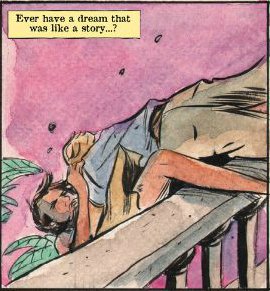 Matt Kindt writes, draw, letters, and colours his first ever solo ongoing series, MIND MGMT. MIND MGMT is a brilliant, mind-bending story about a woman who needs answers for phenomenons that simply don’t have answers. Following the story of Meru and the mysterious Henry Lyme, Matt Kindt builds a beautiful story that is equal parts Twilight Zone and Lost, easily sucking in any reader who enjoys a good, mind bending story. What I found most intriguing about the story is how divisive it made me, loathing the first three issues before absolutely falling head-over-heels in love with the final three issues in the collection. To me, it was an instance of “weathering the storm”, where I had to stomach something I didn’t necessarily love to make me appreciate it that much more. It’s hard to say whether it was intentional on Matt Kindt’s part, or simply a happy coincidence, but nonetheless MIND MGMT is a story that only shines more brightly the further you delve into it.
Matt Kindt writes, draw, letters, and colours his first ever solo ongoing series, MIND MGMT. MIND MGMT is a brilliant, mind-bending story about a woman who needs answers for phenomenons that simply don’t have answers. Following the story of Meru and the mysterious Henry Lyme, Matt Kindt builds a beautiful story that is equal parts Twilight Zone and Lost, easily sucking in any reader who enjoys a good, mind bending story. What I found most intriguing about the story is how divisive it made me, loathing the first three issues before absolutely falling head-over-heels in love with the final three issues in the collection. To me, it was an instance of “weathering the storm”, where I had to stomach something I didn’t necessarily love to make me appreciate it that much more. It’s hard to say whether it was intentional on Matt Kindt’s part, or simply a happy coincidence, but nonetheless MIND MGMT is a story that only shines more brightly the further you delve into it.
Inside of its enthralling and fascinating nature, MIND MGMT is likely to leave you confused for the first bit of the story, before unfurling key secrets as the story carries on. The story opens with a scene that features so much carnage that it makes a slasher film look like it plays in the little leagues before reeling it all back in to sink into the perplex series of stories surrounding the lead character in Meru. As you climb through the first three issues, absolutely unsure of what the heck is going on, you get a sense of some peculiar obstacles being in play that are all linked together somehow, you just can’t quite put it together until Matt Kindt gives you the right kind of answers. It feels almost Indiana Jones-esque in a way at times, as the plot whisks you from one exciting locale to the next as Meru tries to piece everything together for her own sake. It’s when issue four finally rolls around and begins to explain the interesting life of Henry Lyme that you’ll likely come to realize what a magnificent piece of art Matt Kindt has produced with MIND MGMT.
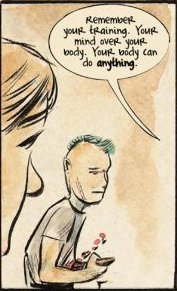 Your two primary characters of Meru and Henry Lyme are clear dividing points in the story. Where Meru is the curious woman with one thousand questions, being upfront of who she is while still trying to discover who she is, Henry Lyme is the enigma with all the answers to every question Meru has. In each of the first issues, Meru finds another question she needs to ask while in the last three issues Henry Lyme provides some answers for nearly every question. It’s difficult to type about the characters without spoiling everything but it’s just one of those stories that legitimately made me go “oh! Wow, it all makes sense now…” when the pieces started to fall into place. The leads of Meru and Henry are similar yet so wildly different at the same time, something which Matt Kindt nails with the way he writes his characters in this volume. Beyond your two leads, Kindt introduces a handful of other meaningful characters who are just as interesting as Meru or Henry and still affect the plot in dynamic ways.
Your two primary characters of Meru and Henry Lyme are clear dividing points in the story. Where Meru is the curious woman with one thousand questions, being upfront of who she is while still trying to discover who she is, Henry Lyme is the enigma with all the answers to every question Meru has. In each of the first issues, Meru finds another question she needs to ask while in the last three issues Henry Lyme provides some answers for nearly every question. It’s difficult to type about the characters without spoiling everything but it’s just one of those stories that legitimately made me go “oh! Wow, it all makes sense now…” when the pieces started to fall into place. The leads of Meru and Henry are similar yet so wildly different at the same time, something which Matt Kindt nails with the way he writes his characters in this volume. Beyond your two leads, Kindt introduces a handful of other meaningful characters who are just as interesting as Meru or Henry and still affect the plot in dynamic ways.
In terms of dialogue, I found that Matt Kindt made some strange but enjoyable choices with the way he choose to have characters tell the story as well as interact with each other. In illustrating the book himself, Kindt seems to actively choose to avoid drawing many scenes where characters talk face to face and show their emotions or reactions to what they’re told. Instead, Kindt will have two characters conversing but have their words appear as captions over top of other parts of the story. For example, Henry begins to reveal key secrets to Meru as they speak directly to each other, but instead of showing us Meru and Henry talking we instead see the story of what Henry is saying. It’s a deft way to tell the story that keeps the plot moving at a brisk pace and avoids lots of “talking heads” on the page. In writing the story and basing his dialogue around this style, Kindt keeps the wheels spinning and never leaves the reader feeling like they’re missing something. It’s as if he’s giving you the best parts of the “show and tell” aspect of comics, instead of just showing or telling you what you need to see or read as a reader.
Collects: MIND MGMT #1-6
Best Character: Henry Lyme
Best Line Of Dialogue/Caption: “Ever have a dream that was like a story? And at the end of the dream there’s a twist ending?” – Henry Lyme
Best Scene/Moment: A bad dream – Issue 5
Best Issue: Issue #4. Issue #4 makes the entire story take a dramatic and exciting turn that you might not expect. It is the first chapter that starts to pull back the facade and show you who Henry Lyme actually is after three issues worth of build up. It’s peculiar too because, Issue 5 might actually be a more exciting and potentially more enjoyable issue just because of how much more it explains but the fourth issue is the integral building block that sets up everything else that happens in the final two issues of this collection. Issue 4 is a clear turning point for the series that grips you so tightly that you’re almost shocked when it lets you go after it concludes. It’s an issue I didn’t want to stop reading and wished would go on forever because of how much it explained and set up future narratives.
Why You Should Read It: This is the perfect style of comic for a reader who wants to have their brain challenged in a way they wouldn’t expect. It’s like the best parts of something like The Twilight Zone in a comic book. The story is fascinating and this is a comic designed for a reader who loves story over world building. Everything Kindt does in this first volume of MIND MGMT has purpose, clearly teeing up the series for the long game and it’s all done in a way that keeps you hooked from start to finish. MIND MGMT is worthy of any reader who likes a good twist of their brain.
Rai Vol 1: Welcome to New Japan
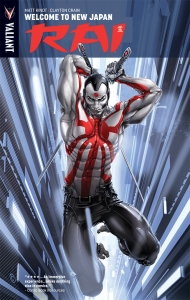 Although well-known for his spy related comic work, in recent years Matt Kindt has started to dip his toes into the superhero end of the comic pool. Before 2012, Kindt had never done a solo ongoing series but following that endeavour, he took on superhero work from the likes of DC Comics, Marvel, and Valiant Entertainment. After brief runs on books like Suicide Squad and Marvel Knights: Spider-Man, Kindt graduated over to Valiant to write books for the characters of Rai, Ninjak, and Unity.
Although well-known for his spy related comic work, in recent years Matt Kindt has started to dip his toes into the superhero end of the comic pool. Before 2012, Kindt had never done a solo ongoing series but following that endeavour, he took on superhero work from the likes of DC Comics, Marvel, and Valiant Entertainment. After brief runs on books like Suicide Squad and Marvel Knights: Spider-Man, Kindt graduated over to Valiant to write books for the characters of Rai, Ninjak, and Unity.
In the year 4001, New Japan has ascended high above the planet Earth, becoming an unprecedented technological hub. With thousands of different sectors built on top of each other, New Japan is constantly pushing itself forward in new and creative ways for the future. When the first murder in over a thousand years occurs in New Japan, The Father, a mysterious force that oversees New Japan, sends out its techno-humanoid enforcer, Rai. Rai is capable of travelling all over the “grid” of New Japan, appearing anywhere within the reach of The Father to disperse justice accordingly. When Rai arrives in the sector where the murder occurred, he is forced to track down “raddies”, humans who hate The Father and don’t respect technology in the same way that other citizens of New Japan do. Life becomes difficult for Rai when he begins to encounter the legendary Spylocke, as well as discovering that he has a personal tie to the victim of the murder. The truths that Rai begins to uncover threaten to destroy everything he thought he knew about his existence, leading him down a bloody path on his way to finding these shocking revelations.
Matt Kindt reboots the character of Rai for the Valiant Universe with this first collected edition of Rai stories. Kindt unleashes a series of issues that leave me feeling unfair in terms of the judgement I want to dole out on them, as by the end of the volume you can’t help but feel as though you’re missing part of the story. Full disclosure: I’ve read a small amount of Valiant comics so it’s definitely not a company of which I have a ridiculous amount of knowledge towards. As such, I was a little taken out of the action of this volume as it felt like there was some form of subtext I was supposed to be picking up on from the history surrounding this character. Coming into this story knowing that this was a full on reboot of a character I’d never even read before made me feel at peace with what I was about to dive into but then as the plot picked up, parts of it just didn’t connect in the way I felt they should.
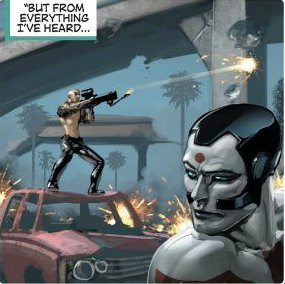 I found the concepts of what was at play fairly easy to pick up on but struggled to connect to the characters and none of this was helped along by a predictable plot. In the far future, Japan has industrialized itself to the point where it no longer is part of Earth and constantly builds sectors on top of each other to help push technology forward. As such, there are thousands of sectors, with how high up your sector is directly correlating to your social class. A higher sector equates to a higher social class, with your lower sectors, who are less technologically advanced, coming to resent the sectors above them and resulting in the formation of anti-technology radicals or “raddies” for short. These “raddies” look to directly overthrow the Artificial Intelligence that governs much of New Japan. This AI, known as The Father, is a mysterious being of whom no one has ever seen or spoken to. Your central conflict falls between The Father and the raddies as each are out to assert their own dominance over New Japan, with the Father looking to wipe away these less essential humans while the “raddies” want to cripple everything The Father has built. This leaves Rai in an awkward middle position as the enforcer of The Father’s law but begins to become weary of The Father when he realizes that there is a lot of information being withheld from him. It’s all fairly straight forward; your radical “non-believers” versus a “holy spirit” with the conflicted hero in the middle. It actually becomes a near battle of faith versus science, as Rai must choose if he agrees with the beliefs of the “raddies” or the scientific nature programmed into him by The Father.
I found the concepts of what was at play fairly easy to pick up on but struggled to connect to the characters and none of this was helped along by a predictable plot. In the far future, Japan has industrialized itself to the point where it no longer is part of Earth and constantly builds sectors on top of each other to help push technology forward. As such, there are thousands of sectors, with how high up your sector is directly correlating to your social class. A higher sector equates to a higher social class, with your lower sectors, who are less technologically advanced, coming to resent the sectors above them and resulting in the formation of anti-technology radicals or “raddies” for short. These “raddies” look to directly overthrow the Artificial Intelligence that governs much of New Japan. This AI, known as The Father, is a mysterious being of whom no one has ever seen or spoken to. Your central conflict falls between The Father and the raddies as each are out to assert their own dominance over New Japan, with the Father looking to wipe away these less essential humans while the “raddies” want to cripple everything The Father has built. This leaves Rai in an awkward middle position as the enforcer of The Father’s law but begins to become weary of The Father when he realizes that there is a lot of information being withheld from him. It’s all fairly straight forward; your radical “non-believers” versus a “holy spirit” with the conflicted hero in the middle. It actually becomes a near battle of faith versus science, as Rai must choose if he agrees with the beliefs of the “raddies” or the scientific nature programmed into him by The Father.
Rai struggles the most with making you connect, which is odd considering how technologically centred the story is. It feels like the themes at play are ones that should be quite relevant for this current generation but nonetheless, it just feels like there are times when you’re trying to process a little bit too much from Kindt. It’s all intelligent work, but there’s so much that gets packed into just four issues that you can get lost in a bit of delicate complexity. The plot has a constant forward moving attitude, such to the point where you barely get time to digest what’s occurring in front of you. You go from learning about this mysterious Rai character, to watching him quickly try to solve this murder and instill Father’s justice on the culprits, to fighting “raddies” and then making allegiances with characters you just met. It’s a steady stream of new information which can be good, but it’s thrown at you in such a way that you really don’t have much time to decide what you’d like to see done with it. Have you ever tried to read a book, climb through five or ten pages of words only to then realize that you really didn’t take in what happened on those pages at all? You suddenly hit a point in the story where that information you didn’t take in becomes relevant but you can’t bring the information forth because it didn’t stick with you. That’s a lot what reading this first volume of Rai felt like. The information is all there, and it all makes complete sense when you slow down to take it in, but it just doesn’t stick in the moment sometimes.
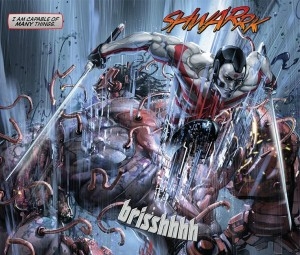 When it comes to the characters, they’re simply forgettable. Rai speaks too much in caption for his own good and not enough through natural dialogue. It hurts the character tremendously even if it makes sense for how the character is. Here is a half tech half human character who is seldom seen or heard coming into the scene to try to solve the first murder in New Japan in over 1000 years. The character is already naturally set up to not be a social butterfly which, again, makes sense given the context of everything going on in the story. But then he’s put in a position to develop and flourish but he never does. Time and time again he’s given characters to speak to dynamically, who can change how he acts and his words just hit in a flat manner. It’s like a master musician hitting that one note that takes you out of the song entirely. Then Matt Kindt seems to have the same problem with introducing the other characters as well, as from Spylocke to Lula or even Augustus Silk, none of them remain truly memorable in my eyes. That’s not to say that these characters don’t have their own moments, either with Rai or even other characters, that spark general interest, it’s just that for the most part they don’t have any dynamic effect with what they choose to do.
When it comes to the characters, they’re simply forgettable. Rai speaks too much in caption for his own good and not enough through natural dialogue. It hurts the character tremendously even if it makes sense for how the character is. Here is a half tech half human character who is seldom seen or heard coming into the scene to try to solve the first murder in New Japan in over 1000 years. The character is already naturally set up to not be a social butterfly which, again, makes sense given the context of everything going on in the story. But then he’s put in a position to develop and flourish but he never does. Time and time again he’s given characters to speak to dynamically, who can change how he acts and his words just hit in a flat manner. It’s like a master musician hitting that one note that takes you out of the song entirely. Then Matt Kindt seems to have the same problem with introducing the other characters as well, as from Spylocke to Lula or even Augustus Silk, none of them remain truly memorable in my eyes. That’s not to say that these characters don’t have their own moments, either with Rai or even other characters, that spark general interest, it’s just that for the most part they don’t have any dynamic effect with what they choose to do.
Like I mentioned early on in the post, things like the concepts and themes of this book are what ended up being the most engage part of this comic to me. The structure of the New Japan government was the runaway most fascinating piece of work done by Matt Kindt here, and that does largely centre on the character of Rai even if as a character he wasn’t overly compelling. Although the relationship between Rai and The Father is plainly predictable, it is still interesting at points of the story to see where it begins to push Rai. The deceptive nature of this overlord like A.I. and how little he’s actually told Rai provides some twists you can see coming from a mile away but the prospect of how they will influence Rai down the road is an appetizing tease for fans who will stay loyal to the series. Even with predictable twists, Kindt still churns out a book with a moment or two that will shock the reader and give you faith that with time this series can iron out the kinks it has in its system.
Collects: Rai #1-4
Best Character: Rai
Best Line Of Dialogue/Caption: “He doesn’t want to see me get hurt. I get that. He can’t bring himself to say it…he needs me.” – Lula
Best Scene/Moment: The exhaust release management scene – Issue 4
Best Issue: Issue 4. Issue 4 is when my feelings for this series finally started to turn a corner. Matt Kindt’s set up in the previous three issues actually pays off in a fairly satisfying way with this final issue in the collection. You have a Rai driven to carnage over the truth before coming to grips with it, a somewhat team up between Spylocke and Lula, plus Rai finally encounters The Father. It all comes together with the final pages of the issue as Kindt sneaks in a genuinely surprising scene I never saw coming.
Why You Should Read It: All negativity aside, Rai is a series you should read after you acclimatize yourself with the Valiant Universe a bit more. It’s definitely not what I’d recommend as an entry-level read but it is a book that payoffs your patience if you’re willing to give it a shot. Rai is far from perfect but there’s still enough going on that I’m positive it reads better a second time through when you have a bit of a better understanding of what you’re jumping into. It’s got some brilliant concepts and ideas at play, is visually beautiful, and has a moment towards the end of the fourth issue that completely redeemed my entire outlook on the series up to that point.

